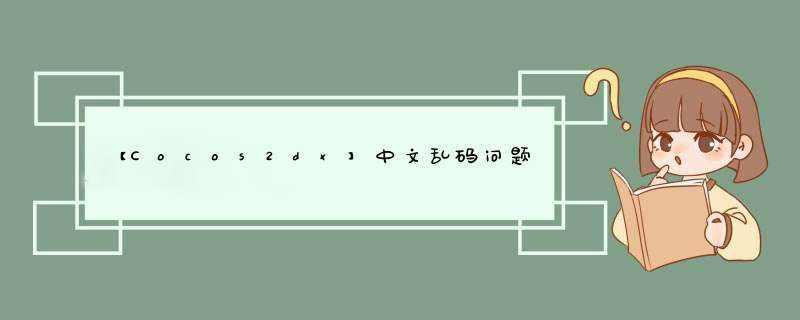
Cocos2dx的中文乱码问题,造成原因是VS将其以GBK编译,而Cocos2dx本身的引擎是UTF-8,所以非西欧字符会出现乱码。谁让cocos2d-x是由cocos2d而来,而cocos2d这东西是老外写的呢?引擎的编写者根本没有考虑这点。
解决的方式有很多种,比如在VS写一段转码函数,引入Cocos2dx的iconv库,但这都不是好方法,主流的解决方法是将中文字符串写到UTF-8编码的XML文件中,然后仿照AndroID中的strings.xml解析XML文件,而且这种方法还方便以后的国际化、跨平台编译。
首先在工程目录下的资源文件夹Resources,新建一个字符文件strings.xml,以后编写Cocos2dx的时候,养成写安卓的习惯,把所有字符藏在这个strings.xml之中。Cocos2dx的资源文件夹在《【Cocos2dx】资源文件夹,播放背景音乐,导入外部库》(点击打开链接)已经说了,这里不再赘述。
例如如下的一段strings.xml代码:
<dict> <key>HelloWorldString</key> <string>你好,世界</string></dict>
如下图,记得,以UTF-8的编码形式保存,windows下的记事本默认编码是ANSI。
之后在Cocos2dx通过如下形式,读取这个strings.xml,加载一个一个key标签下对应的字符串string
//利用CCDictionary来读取xml CCDictionary *strings = CCDictionary::createWithContentsOffile("strings.xml");//载入资源文件夹的strings.xml //读取HelloWorld键中的值objectForKey根据key,获取对应的string const char *HelloWorld = ((CCString*)strings->objectForKey("HelloWorldString"))->m_sstring.c_str(); 如上的代码,就是将HelloWorldString这个key对应的String,读入到HelloWorld这个字符指针中。毕竟C++没有原生的String。只能用const char *HelloWorld来指向“你好,世界”这个字符。 #include "HelloWorldScene.h"USING_NS_CC;CCScene* HelloWorld::scene(){ // 'scene' is an autorelease object CCScene *scene = CCScene::create(); // 'layer' is an autorelease object HelloWorld *layer = HelloWorld::create(); // add layer as a child to scene scene->addChild(layer); // return the scene return scene;}// on "init" you need to initialize your instancebool HelloWorld::init(){ //利用CCDictionary来读取xml CCDictionary *strings = CCDictionary::createWithContentsOffile("strings.xml");//载入资源文件夹的strings.xml //读取HelloWorld键中的值objectForKey根据key,获取对应的string const char *HelloWorld = ((CCString*)strings->objectForKey("HelloWorldString"))->m_sstring.c_str(); //获取屏幕的尺寸、位置信息等 CCSize visibleSize = CCDirector::sharedDirector()->getVisibleSize(); //乱码文字 cclabelTTF *label0 = cclabelTTF::create("你好,世界","arial",72); label0->setposition(ccp(visibleSize.wIDth/2,2*visibleSize.height/3)); this->addChild(label0); //正常中文 cclabelTTF *label1 = cclabelTTF::create(HelloWorld,72); label1->setposition(ccp(visibleSize.wIDth/2,visibleSize.height/3)); this->addChild(label1); return true;}voID HelloWorld::menuCloseCallback(CCObject* pSender){#if (CC_TARGET_PLATFORM == CC_PLATFORM_WINRT) || (CC_TARGET_PLATFORM == CC_PLATFORM_WP8) CcmessageBox("You pressed the close button. windows Store Apps do not implement a close button.","Alert");#else CCDirector::sharedDirector()->end();#if (CC_TARGET_PLATFORM == CC_PLATFORM_IOS) exit(0);#endif#endif} 如上的代码,如果将“你好,世界”生成cclabelTTF直接输出,则会是乱码,如果将“你好,世界”从资源文件夹Resources下的strings.xml,这个编码为UFT-8的文件读入到const char *HelloWorld,再生成cclabelTTF输出,是没有问题的。如下图所示:
这样,通过strings.xml还能使跨平台编译、国际化变得非常方便。
总结以上是内存溢出为你收集整理的【Cocos2dx】中文乱码问题全部内容,希望文章能够帮你解决【Cocos2dx】中文乱码问题所遇到的程序开发问题。
如果觉得内存溢出网站内容还不错,欢迎将内存溢出网站推荐给程序员好友。
欢迎分享,转载请注明来源:内存溢出

 微信扫一扫
微信扫一扫
 支付宝扫一扫
支付宝扫一扫
评论列表(0条)